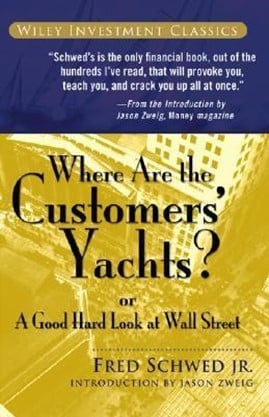Where Are the Customers’ Yachts? by Fred Schwed Jr.
Book No. 3: Where Are the Customers’ Yachts? by Fred Schwed Jr.
(Source: GoodReads.com)
A wry look at the hypocrisy that lies in the business of investing, particularly among financial advisers and brokers, Where Are the Customers’ Yachts? rounds out our reading list.
An ancient, perhaps fanciful, tale inspired the quirky title ofthis 1940’s critique of Wall Street. As the story goes, a local Manhattan resident and an out-of-town visitor were strolling along the shoreline of Battery Park when the local boasted, “Look, those are the bankers’ and brokers’ yachts!”
The friend innocently replied, “Where are the customers’ yachts?”
In keeping with that ironic title, author Fred Schwed provides an array of folksy – and sometimes irreverent – insights into the real world of investing. A few of my favorite quotes include…
- Those classes of investments considered “best” change from period to period. The pathetic fallacy is that what are thought to be the best are in truth only the most popular – the most active, the most talked of, the most boosted, and consequently, the highest in price at that time. It is very much a matter of fashion…
- Investment and speculation are said to be two different things, and the prudent individual is advised to engage in the one and avoid the other. This is something like explaining to the troubled adolescent that Love and Passion are two different things. [The adolescent] perceives that they are different, but they don’t seem quite different enough to clear up [the confusion]… Speculation is an effort, probably unsuccessful, to turn a little money into a lot. Investment is an effort, which should be successful, to prevent a lot of money from becoming a little.
- Like all of life’s rich emotional experiences, the full flavor of losing important money cannot be conveyed by literature…Nor can any description that I might offer here even approximate what it feels like to lose a real chunk of money that you used to own.
Schwed’s core message is not that Wall Street is “bad,” or that professional investors are scoundrels; his message is simply a plea to apply common sense to the investment process.
That sort of common sense begins with a realistic assessment of one’s personal risk tolerance, and ends with a sober assessment of the risk and reward each investment opportunity offers.
That’s a message that applies to every investor of every generation.
Incidentally, this book is a favorite of Michael Bloomberg's, who said…
How great to have a reissue of a hilarious classic that proves the more things change the more they stay the same. Only the names have been changed to protect the innocent.

Comments
Post a Comment